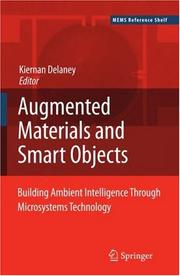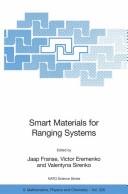| Listing 1 - 4 of 4 |
Sort by
|
Book
ISBN: 1780675585 9781780673448 1780673442 9781780675589 9781780675343 1780675348 Year: 2013 Publisher: London : Laurence King Publishing,
Abstract | Keywords | Export | Availability | Bookmark
 Loading...
Loading...Choose an application
- Reference Manager
- EndNote
- RefWorks (Direct export to RefWorks)
Over the last ten years there has been a huge growth in the area of materials for design, but most books on this subject deal with advanced, semi-formed materials (that is, materials sold as sheet, rod, tube, etc.). This book provides much-needed information on the raw materials, and the low-down on how these can be used. Organized into three sections embracing grown, oil-based, and mined materials, each entry includes information on key features, typical applications, production processes, and sustainability issues. This fact-packed book will allow professional designers and students from a range of disciplines to understand in simple, exciting, visual terms the different qualities and features of materials.
Industrial design. --- Design, Industrial --- Sustainable design. --- Smart materials in design. --- Raw materials. --- Engineering materials --- Industrial materials --- Green design --- smart materials --- industrial design --- sustainable development --- Product design. --- Mechanical drawing --- New products --- Design --- Materials. --- Engineering --- Engineering design --- Manufacturing processes --- Primary commodities --- Commercial products --- Industrial design --- Materials --- Design and construction --- Environmental protection. Environmental technology --- Materials sciences --- Materiaalleer --- MAD-faculty 19 --- designconcept --- materialen --- Product design --- Sustainable design --- Smart materials in design --- Raw materials --- 745.5 --- designmaterialen --- design --- designmaterialen - algemeen

ISBN: 9780387462646 0387462635 9780387462639 0387462643 Year: 2008 Publisher: New York : Springer,
Abstract | Keywords | Export | Availability | Bookmark
 Loading...
Loading...Choose an application
- Reference Manager
- EndNote
- RefWorks (Direct export to RefWorks)
Ambient Intelligence with Microsystems: Augmented Materials and Smart Objects This text investigates relationships that Ambient Intelligence has with current and emerging Microsystems Ambient Intelligence conceptualizes systems that are proactive, context-aware and unobtrusive. Microsystems enable these systems to be seamlessly integrated into everyday objects. This work examines the opportunities and challenges in using integrated computing with MEMs sensors. It evaluates the impact of trends towards embedded sub-systems, including System-in-a-Package solutions, as well as rapidly growing areas of research, such as wireless sensor networks. Methods for realizing smart objects are discussed, including smart textiles, intelligent surfaces, smart tracking and environmental monitoring systems, This provides for an infrastructure of heterogeneous systems attached to (or physically embedded in) everyday objects that enable collections of smart objects to collaborate and provide services. Technical barriers are discussed as well as methods to meet the challenges of what is a strongly collaborative process. Co-design is integral to this; for optimal results the goal must be co-innovation, with the needs of key stakeholders recognised and addressed. Ambient Intelligence with Microsystems: Augmented Materials and Smart Objects discusses the vision statements relevant to future embedded sensor platforms for smart objects and, ultimately, Ambient Intelligence. Readers will find up to-date research in Ambient Intelligence and in Microsystems including; A practical approach to realizing concepts within Ambient Intelligence, including new heterogeneous systems infrastructures and international R&D programs Analyses of embedded microelectronic sub-systems and novel assembly techniques for autonomous MEMs sensors. Reviews of initiatives in collaborative research that are leading to innovation in hardware, networking and software, including the effect of whole-systems methodologies Ambient Intelligence with Microsystems: Augmented Materials and Smart Objects is written for researchers and professionals in the areas of microsystems, smart materials, ambient and pervasive systems, and those investigating and exploiting wireless sensor networks.
Engineering. --- Electronics and Microelectronics, Instrumentation. --- Materials Science. --- Artificial Intelligence (incl. Robotics). --- Systems and Information Theory in Engineering. --- Artificial intelligence. --- Electronics. --- Ingénierie --- Intelligence artificielle --- Electronique --- Embedded computer systems. --- Electrical Engineering --- Computer Science --- Electrical & Computer Engineering --- Engineering & Applied Sciences --- Ambient intelligence. --- Smart materials. --- Adaptive materials --- Intelligent materials --- Sense-able materials --- AmI (Ambient intelligence) --- Intelligence, Ambient --- Embedded systems (Computer systems) --- Computer science. --- Complexity, Computational. --- Microelectronics. --- Materials science. --- Computer Science. --- Materials Science, general. --- Complexity. --- Materials --- Human-computer interaction --- Ubiquitous computing --- Computer systems --- Architecture Analysis and Design Language --- Voice computing --- Materials. --- Artificial Intelligence. --- Construction --- Industrial arts --- Technology --- Engineering --- Engineering materials --- Industrial materials --- Engineering design --- Manufacturing processes --- Electrical engineering --- Physical sciences --- AI (Artificial intelligence) --- Artificial thinking --- Electronic brains --- Intellectronics --- Intelligence, Artificial --- Intelligent machines --- Machine intelligence --- Thinking, Artificial --- Bionics --- Cognitive science --- Digital computer simulation --- Electronic data processing --- Logic machines --- Machine theory --- Self-organizing systems --- Simulation methods --- Fifth generation computers --- Neural computers --- Computational complexity. --- Complexity, Computational --- Material science --- Microminiature electronic equipment --- Microminiaturization (Electronics) --- Electronics --- Microtechnology --- Semiconductors --- Miniature electronic equipment

ISBN: 9781402046469 1402046448 9781402046445 1402046456 9786610611072 1280611073 1402046464 Year: 2006 Volume: v. 226 Publisher: Dordrecht Springer
Abstract | Keywords | Export | Availability | Bookmark
 Loading...
Loading...Choose an application
- Reference Manager
- EndNote
- RefWorks (Direct export to RefWorks)
The problem of determining the location of an object, which is usually called ranging, attracts at present much attention in many different areas of applications, among them in ecological and safety devices. Electromagnetic waves along with sound waves are widely used for this purpose. Familiar examples of ranging systems are radar, sonar, GPS positioning, speed meters, etc.. Most are echo-type of devices, generating a wave and interpreting its echo from the object of interest. GPS is a cooperative system, in which the receiver observes timing signals from sources at known locations, and locates itself in reference to them. Passive ranging makes use of waves generated by the object to be located that are picked up by an observer. As indicated, there are three kinds of ranging systems, successively described as echo, cooperative and passive systems. Echo ranging is by far the most common method in practice. The observer at a certain point emits a wave of some physical nature at a certain time. When the outgoing wave front strikes the object, a scattered wave front is launched, which is detected at the observer point a certain time interval later.
Electronics and optics of solids --- supergeleiding --- Quantum mechanics. Quantumfield theory --- Electromagnetism. Ferromagnetism --- optica --- magnetisme --- quantummechanica --- fysica --- Solid state physics --- Smart materials --- Matériaux intelligents --- Congresses. --- Congrès --- EPUB-LIV-FT LIVPHYSI SPRINGER-B --- Congresses --- Magnetism. --- Condensed Matter Physics. --- Magnetism, Magnetic Materials. --- Strongly Correlated Systems, Superconductivity. --- Optics, Lasers, Photonics, Optical Devices. --- Mathematical physics --- Physics --- Electricity --- Magnetics --- Condensed matter. --- Magnetic materials. --- Superconductivity. --- Superconductors. --- Lasers. --- Photonics. --- Light amplification by stimulated emission of radiation --- Masers, Optical --- Optical masers --- Light amplifiers --- Light sources --- Optoelectronic devices --- Nonlinear optics --- Optical parametric oscillators --- New optics --- Optics --- Superconducting materials --- Superconductive devices --- Cryoelectronics --- Electronics --- Solid state electronics --- Electric conductivity --- Critical currents --- Superfluidity --- Materials --- Condensed materials --- Condensed media --- Condensed phase --- Materials, Condensed --- Media, Condensed --- Phase, Condensed --- Liquids --- Matter --- Solids
Book
ISBN: 9780387476841 0387476849 9780387476858 9786611492052 1281492051 0387476857 Year: 2008 Publisher: Boston, MA Springer-Verlag US
Abstract | Keywords | Export | Availability | Bookmark
 Loading...
Loading...Choose an application
- Reference Manager
- EndNote
- RefWorks (Direct export to RefWorks)
This book provides a working knowledge of the modeling and applications of shape memory alloys (SMAs) to practicing engineers and graduate and advanced undergraduate students with an interest in the behavior and utility of active or multifunctional materials and "smart" structures. SMAs represent a unique material class with the ability to recover seemingly permanent deformations and provide large forces upon heating. These interesting characteristics have led to an ever-expanding variety of engineering applications which address design problems requiring high force actuation in a confined environment. Such applications range from morphing aerospace structures to medical stents and other biomedical devices. Specifically, this book, which includes theory, problems and references, aims to provide readers with the following: Comprehensive introduction to the behavior of shape memory alloys which includes a review of SMA history, a microstructural description of the observed effects and a summary of engineering applications. Review of the experimental characterization methods used to quantitykey aspects of the thermomechanical behavior of SMAs. Introduction to continuum thermodynamics as applied to the development of thermomechanical SMA constitutive models, including methods of numerical implementation. Presentation of additional modeling options which address specialized SMA material behavior such as transformation-induced plasticity and constitutive modeling of magnetic SMAs. Edited by a recognized expert leading a group with a long history of SMA research, Shape Memory Alloys: Modeling and Applications is a necessary book for students and practicing engineers interested in a thorough understanding of shape memory alloys.
Shape memory alloys --- Alliages à mémoire de forme --- Actuators -- Design and construction. --- Metallic composites. --- Shape memory alloys. --- Shape memory effect. --- Materials Science --- Chemical & Materials Engineering --- Engineering & Applied Sciences --- Alloys. --- Metallic alloys --- Materials science. --- Thermodynamics. --- Heat engineering. --- Heat transfer. --- Mass transfer. --- Continuum mechanics. --- Mechanical engineering. --- Materials --- Thin films. --- Materials Science. --- Materials Science, general. --- Engineering Thermodynamics, Heat and Mass Transfer. --- Continuum Mechanics and Mechanics of Materials. --- Mechanical Engineering. --- Surfaces and Interfaces, Thin Films. --- Surfaces. --- Metallic composites --- Metals --- Phase rule and equilibrium --- Amalgamation --- Microalloying --- Alloys --- Smart materials --- Materials. --- Engineering. --- Mechanics. --- Mechanics, Applied. --- Surfaces (Physics). --- Solid Mechanics. --- Physics --- Surface chemistry --- Surfaces (Technology) --- Engineering, Mechanical --- Engineering --- Machinery --- Steam engineering --- Applied mechanics --- Engineering mathematics --- Classical mechanics --- Newtonian mechanics --- Dynamics --- Quantum theory --- Construction --- Industrial arts --- Technology --- Engineering materials --- Industrial materials --- Engineering design --- Manufacturing processes --- Materials—Surfaces. --- Chemistry, Physical and theoretical --- Mechanics --- Heat --- Heat-engines --- Mechanical engineering --- Thermodynamics --- Material science --- Physical sciences --- Films, Thin --- Solid film --- Solid state electronics --- Solids --- Coatings --- Thick films --- Mass transport (Physics) --- Transport theory --- Heat transfer --- Thermal transfer --- Transmission of heat --- Energy transfer
| Listing 1 - 4 of 4 |
Sort by
|

 Search
Search Feedback
Feedback About UniCat
About UniCat  Help
Help News
News